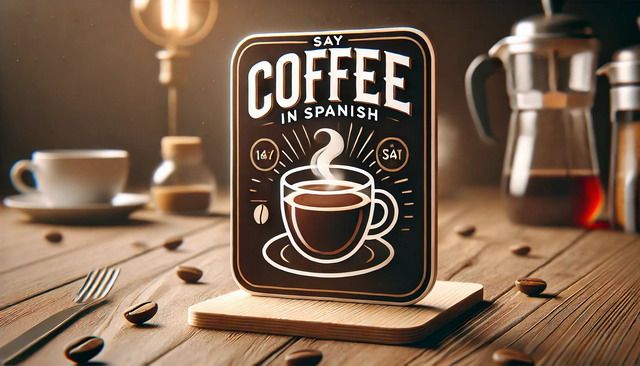How to Say Coffee in Spanish and Different Ways to Order It in Spanish-Speaking Countries
How to Say Coffee in Spanish
If you’re a coffee lover and enjoy the thrill of experiencing new cultures, learning how to say coffee in Spanish is a simple yet powerful step in connecting with Spanish-speaking communities. Whether you’re planning a trip to Spain or exploring the rich coffee cultures of Latin America, knowing a few key phrases can enhance your experience and make your morning coffee run much smoother.
In this article, we will explore how to say “coffee” in Spanish, discuss some common ways to order coffee across different Spanish-speaking regions, and touch upon the cultural nuances surrounding this beloved beverage.
How to Say Coffee in Spanish
In Spanish, the word for “coffee” is café. Pronounced [kah-feh], it is an easy word to remember, and it’s one that you’ll likely use often if you find yourself in any Spanish-speaking country. The accent on the “e” ensures that the pronunciation is correct, with emphasis on the second syllable. Spanish pronunciation can vary slightly from country to country, but “café” is widely understood across the Spanish-speaking world, from Spain to Mexico, to Argentina and beyond.
It’s important to note that café doesn’t just refer to the beverage; it can also refer to a café, or coffee shop. This dual meaning might initially confuse new learners, but context typically clears up whether someone is talking about the drink or the place. For example, if someone says, “Vamos a tomar un café en el café,” it means “Let’s go have a coffee in the café.” The language playfully blends the drink with the social setting, highlighting how intertwined coffee is with daily life and culture in Spanish-speaking countries.
Variations in Pronunciation Across Spanish-Speaking Countries
While “café” remains largely the same word everywhere, pronunciation nuances can emerge depending on the region. In Spain, for example, you might hear a more clipped, slightly faster “kah-feh,” whereas in certain parts of Latin America, the word might be drawn out just a little more or have a slight change in tone. These subtle variations are part of what makes learning and practicing Spanish so exciting—you’ll often hear regional differences in pronunciation and word choice that reflect the diversity of Spanish-speaking countries.
Additionally, in some places like Colombia, local slang or colloquial terms might replace the standard “café.” For instance, in Colombia, tinto is a common word for a black coffee. It’s small differences like these that offer a deeper cultural understanding when you travel. Knowing not only the standard word but also regional variants can be a sign of respect and interest in the local culture.
Different Ways to Order Coffee in Spanish-Speaking Countries
Now that we know how to say “coffee” in Spanish, let’s dive into the various ways you can order coffee depending on your preferences and the country you’re in. Coffee is not a one-size-fits-all beverage, and Spanish-speaking countries offer a variety of ways to customize your order. From rich espressos to creamy milk-based drinks, the options are as diverse as the countries themselves.
Common Coffee Orders
- Café solo – This is the Spanish equivalent of a black coffee or espresso. If you’re in Spain or Latin America and simply ask for a “café,” you’ll likely get a strong, concentrated shot of espresso. For those who prefer their coffee without milk or sugar, this is the ideal choice. It’s bold, straightforward, and packed with flavor. Keep in mind that café solo is typically served in small portions due to its strength.
- Café con leche – Literally translating to “coffee with milk,” this is a popular order for those who enjoy a balanced mix of strong coffee and steamed milk. In Spain, café con leche is usually served in equal parts, making it similar to a latte. The warmth and smoothness of the milk balance out the strong espresso, creating a satisfying, comforting drink. You’ll find that this is a breakfast favorite for many, often paired with a croissant or toast.
- Cortado – A cortado is a smaller, more concentrated version of a café con leche. It’s essentially a shot of espresso “cut” with a small amount of milk to soften the intensity of the coffee. Popular in Spain and parts of Latin America, the cortado is perfect for those who want the bold flavor of espresso but with a touch of creaminess.
- Café Americano – If you prefer a milder cup of coffee, you might want to order a café Americano. Similar to black coffee in the U.S., an Americano is an espresso diluted with hot water, making it less intense than a café solo. This is a common choice for people who enjoy the flavor of espresso but prefer a larger, more sip-friendly drink.
- Café cortadito – In some regions, particularly in Cuba and Miami’s Cuban coffee shops, you may encounter a cortadito, which is similar to a cortado but often comes with sweetened milk. It’s a great option if you enjoy a bit of sweetness in your coffee without adding sugar yourself.
Regional Differences in Coffee Preparation
As you explore different Spanish-speaking countries, you’ll notice that coffee culture and preparation methods vary significantly from region to region. In Spain, for instance, espresso-based drinks like café solo, cortado, and café con leche dominate the scene, with many Spaniards enjoying coffee as part of their morning or afternoon routines. Coffee in Spain is often served quickly and consumed just as fast, with people standing at the bar for a quick pick-me-up.
In contrast, Latin America boasts a wider variety of coffee styles, particularly in countries known for producing coffee beans, such as Colombia, Costa Rica, and Mexico. In Colombia, for example, ordering a tinto (black coffee) is a daily ritual for many, and the country’s high-quality beans are a source of national pride. You’ll also find that in some places, coffee is prepared with different brewing methods—ranging from drip coffee to traditional stovetop espresso makers.
In Argentina, café con leche is often enjoyed during a leisurely breakfast, where coffee culture leans toward socialization and relaxation. While in Mexico, you might come across café de olla, a traditional coffee brewed with cinnamon and piloncillo (unrefined sugar), offering a unique flavor that reflects local tastes.
Learning how to say “coffee” in Spanish is just the beginning of understanding the rich coffee culture across the Spanish-speaking world. Whether you prefer your coffee black, with milk, or sweetened with a touch of sugar, the variety of ways to order this beloved beverage reflects the diversity and vibrancy of each region.
Cultural Significance of Coffee in Spanish-Speaking Countries
Coffee is more than just a drink in many Spanish-speaking countries; it’s a deeply ingrained part of the culture, often intertwined with social interactions, traditions, and even national identity. Whether you’re in a bustling city in Spain or a small village in Colombia, coffee is at the heart of many gatherings and conversations. Understanding the cultural significance of coffee in these countries can deepen your appreciation of both the language and the local way of life.
Coffee as a Social Activity
In many Spanish-speaking countries, coffee is not just consumed for the caffeine; it’s often enjoyed in a social context. Meeting for a coffee (often referred to as “tomar un café”) is a popular way to spend time with friends, family, or colleagues. This is particularly true in Spain, where coffee breaks, known as sobremesa, can last for hours, especially after meals. The term “sobremesa” literally means “over the table,” and it refers to the extended time spent chatting and socializing after a meal, usually with a cup of coffee in hand.
Similarly, in Latin American countries, coffee is often central to both casual and formal gatherings. In Colombia, for example, it’s common for people to invite you over for a cup of tinto (black coffee), which serves as a gesture of hospitality and friendship. Coffee plays a role in building relationships, making connections, and even conducting business in some parts of the world. In Argentina, cafes are often a hub for political discussions and intellectual debates, with café con leche or a strong espresso in hand.
Traditional Coffee Culture Across Spanish-Speaking Regions
While coffee culture has modernized in many parts of the world, traditional methods of making and consuming coffee still hold strong in certain Spanish-speaking countries. In Mexico, for example, the traditional café de olla is a unique coffee brewed in a clay pot (olla) with cinnamon and piloncillo (a type of unrefined brown sugar). This traditional preparation reflects the rich cultural heritage of the country and offers a warm, spiced flavor distinct from the standard espresso-based drinks found elsewhere.
In Guatemala, another major coffee-producing country, you’ll often find coffee served in its simplest form, brewed fresh from locally grown beans. Here, coffee farming is a way of life for many, with small-scale farmers growing high-quality beans in the country’s mountainous regions. For visitors, sipping coffee in Guatemala is an opportunity to connect with the land, the people, and the centuries-old traditions of coffee cultivation.
Spain’s coffee culture is rooted in its café lifestyle, with cafeterías (coffee shops) serving as social hubs where people can relax, read, or have long conversations over coffee. In places like Madrid and Barcelona, it’s common to see people standing at the bar in cafés, sipping a quick café solo before heading off to work, or lingering over a café con leche during an extended afternoon break. In Spain, coffee culture is less about rushing and more about savoring the moment, making it an integral part of daily life.
Famous Coffee-Growing Regions in Spanish-Speaking Countries
Several Spanish-speaking countries are also some of the world’s largest coffee producers, with coffee-growing regions that are renowned for their high-quality beans. Visiting these regions provides a deeper understanding of the coffee production process and the labor behind each cup of coffee you drink.
- Colombia: Known for producing some of the best coffee beans in the world, Colombia’s coffee-growing regions, particularly the Coffee Triangle (Eje Cafetero), are a source of national pride. Colombian coffee is known for its smooth, mild flavor, often with hints of chocolate or fruit. Many coffee farms offer tours where visitors can learn about the process of growing, harvesting, and roasting coffee.
- Costa Rica: Another country famous for its coffee, Costa Rica produces beans known for their bright acidity and full-bodied flavor. Coffee is an essential part of the economy here, with many local farms welcoming visitors to learn about sustainable coffee farming practices. Costa Rican coffee culture is also deeply connected to environmental conservation, as the country focuses on organic and eco-friendly farming methods.
- Guatemala: The volcanic soils of Guatemala provide the perfect conditions for growing rich, flavorful coffee. The country’s coffee-growing regions, such as Antigua and Huehuetenango, are famous for producing beans with complex flavors, often described as smoky or spicy. Guatemalan coffee is a staple export, and the country’s coffee farms are a must-visit for any coffee enthusiast.
Coffee-Related Phrases to Use in Spanish
Now that we’ve covered the cultural and regional aspects of coffee in Spanish-speaking countries, let’s dive into some useful coffee-related phrases you can use when ordering your favorite drink. Learning these phrases not only helps you order coffee more easily, but it also allows you to engage more meaningfully with the locals and enhance your travel experience.
How to Ask for Coffee Politely
When ordering coffee in a Spanish-speaking country, being polite is key. Here are some basic phrases you can use to ask for coffee:
- ¿Me pone un café, por favor? – Can I have a coffee, please?
- ¿Podría darme un café con leche? – Could you give me a coffee with milk?
- Un café solo, por favor. – A black coffee, please.
- ¿Puedo tener un café descafeinado? – Can I have a decaffeinated coffee?
These phrases are simple and polite, ensuring that your request is well received. When ordering, feel free to customize your coffee to your liking by adding milk, sugar, or specifying the size of your drink.
Phrases for Customizing Your Coffee Order
Once you’ve mastered the basics, you can take your coffee ordering skills to the next level by customizing your drink. Here are some common phrases to use:
- Con azúcar – With sugar
- Sin azúcar – Without sugar
- Con leche – With milk
- Con leche fría/caliente – With cold/hot milk
- Con hielo – Iced
- Descafeinado – Decaffeinated
If you’re ordering a specialty coffee, like a café cortado or café de olla, you might want to ask for additional details about the preparation. For example:
- ¿El café cortado lleva mucha leche? – Does the cortado have a lot of milk?
- ¿El café de olla tiene azúcar? – Does the café de olla have sugar?
Useful Vocabulary for Coffee Lovers
- Taza – Cup
- Azúcar – Sugar
- Leche – Milk
- Descafeinado – Decaffeinated
- Café helado – Iced coffee
- Cafetería – Coffee shop
Mastering this vocabulary and these phrases will make ordering coffee a breeze, whether you’re in a local café in Madrid or a bustling coffee shop in Bogotá. Not only will it enhance your experience, but it will also give you an opportunity to practice your Spanish and connect with the local culture on a deeper level.
Common Variations of Coffee-Related Vocabulary
As you continue to immerse yourself in Spanish-speaking cultures, you’ll notice that even within the familiar word “café,” there are numerous variations and subtle nuances depending on the country, region, or even the local café. From unique slang to coffee-related idioms, understanding these differences can add richness to your language skills and enhance your ability to communicate like a local.
Café vs. Cafetería: Knowing the Difference
While “café” is universally understood as both the word for coffee and a coffee shop, in Spanish, there is a distinct word specifically for a coffeehouse or coffee shop: cafetería. For instance, if you want to invite someone to a coffee shop, you would say, “Vamos a la cafetería,” meaning, “Let’s go to the coffee shop.”
The difference between “café” (the drink) and “cafetería” (the place) is subtle but important. While you can still use “café” to refer to the establishment in many informal contexts, particularly when you’re in the middle of a conversation about coffee, it’s helpful to know the proper term when you’re trying to be clear or formal.
In addition to this, the term “cafetería” might be used more broadly in some countries, referring to a place where a wider variety of snacks or meals is also served, rather than just coffee. It’s always helpful to pay attention to the context and how these words are used to avoid confusion.
Local Slang for Coffee
In some Spanish-speaking regions, coffee has its own set of colloquial names, which can be fun to learn and use. For example:
- Tinto (Colombia): In Colombia, you might hear locals asking for a tinto instead of a café solo. A tinto refers to a black coffee, typically served in a small cup. It’s a common, everyday beverage enjoyed throughout the day, whether at home or in cafes.
- Café cortadito (Cuba): This Cuban variation of the cortado is usually sweetened, offering a unique and tasty take on the espresso-with-milk combination. Ordering a café cortadito in Miami, where Cuban coffee culture thrives, will earn you a strong, sweet coffee experience.
- Café de olla (Mexico): As mentioned earlier, café de olla is a traditional Mexican coffee brewed with cinnamon and piloncillo, giving it a distinct and rich flavor that is unique to Mexico’s coffee culture.
Coffee-Related Idioms in Spanish
Much like in English, coffee has made its way into various idiomatic expressions in Spanish. Learning these idioms is not only useful for improving your language skills but also for gaining insight into the culture’s love of coffee. Some common coffee-related idioms include:
- “Estar como un café bien cargado” – This phrase translates to “to be as strong as a well-loaded coffee” and is used to describe someone who is full of energy or very excited.
- “No todo es café con leche” – This idiom, which means “not everything is coffee with milk,” is used to express that not everything in life is simple or easy.
- “Tomar café para todos” – Translating to “coffee for everyone,” this phrase is used to describe a situation where resources or benefits are shared equally among people, much like how coffee is a common drink enjoyed by everyone.
These idioms highlight how coffee permeates everyday conversation, not just as a drink but as a cultural reference point.
Why Learning Basic Coffee Terms in Spanish is Useful
Learning coffee-related vocabulary in Spanish isn’t just about being able to order your morning brew. It’s about understanding the deeper cultural significance that coffee holds in Spanish-speaking countries and using it as a gateway to explore the language and people more profoundly. Here’s why mastering these basic terms is so useful:
- Practical for Travel
If you find yourself in Spain, Mexico, Colombia, or any other Spanish-speaking country, knowing how to order coffee can make your daily interactions smoother and more enjoyable. Whether you’re visiting a small, local coffee shop in a quiet town or ordering in a bustling city, being able to confidently say “Un café con leche, por favor” instantly connects you to the local culture and helps you navigate your surroundings with ease.
- Enhances Cultural Experiences
Coffee is a deeply social beverage in many Spanish-speaking countries, and being able to engage with this aspect of culture enriches your travel experience. Sitting down for a café cortado in a Spanish plaza or sharing a tinto in Colombia allows you to participate in a cherished tradition. By using the local language to order and talk about coffee, you’re also demonstrating respect for the culture and increasing your opportunities to interact with locals in an authentic way.
- Builds Confidence in Language Learning
Mastering coffee-related phrases is a simple yet effective way to build your confidence when learning Spanish. Coffee orders are something you can practice daily, making it a consistent and fun way to reinforce your language skills. The more comfortable you become with these terms, the more likely you are to explore new vocabulary and engage in deeper conversations.
- Insight into Everyday Life
Asking for coffee is a common, everyday task in many places, but it also provides insight into the local way of life. From the way coffee is prepared to the social rituals surrounding its consumption, you’ll gain a deeper understanding of the values, traditions, and habits of the people in the places you visit.
Conclusion
Mastering how to say “coffee” in Spanish, along with the various ways to order and enjoy it, opens up a world of cultural experiences and connections. Whether you’re sipping a café solo in Spain, savoring a café de olla in Mexico, or enjoying a tinto in Colombia, coffee is more than just a drink—it’s an integral part of life that brings people together. By learning these essential coffee-related terms and phrases, you’ll not only enhance your language skills but also gain a richer understanding of the cultures that treasure this iconic beverage.
So, the next time you find yourself in a Spanish-speaking country, don’t hesitate to step into a local café and confidently order your favorite coffee in Spanish. You’ll be participating in a beloved tradition while deepening your own experience of language and culture.








